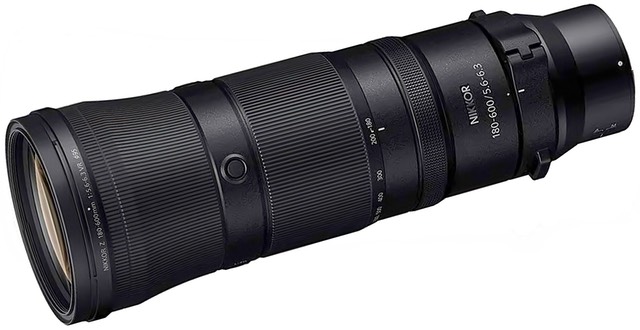
What is It?
The 180-600mm f/5.6-6.3 VR lens was on the Road Map long before it appeared in public, and has been one of the most eagerly awaited lenses in the Z system lineup. Heck, the lens was on the Road Map for so long it gained 20mm in extra focal length range (it was originally listed as 200-600mm).
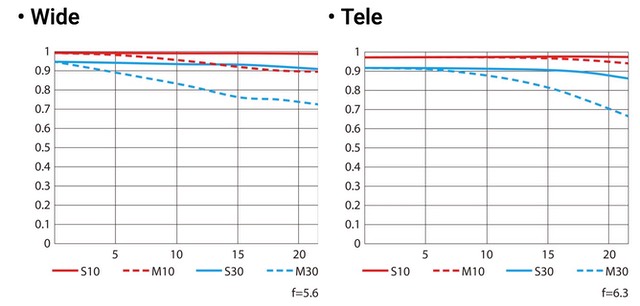
When the 180-600mm f/5.6-6.3 VR was announced, one of the most intriguing things about it was Nikon's published MTF numbers (shown above; theoretical, not measured). These showed a lens that was excellent from center to edge, with less than expected falloff in fine detail and no real sign of any big issues (e.g. field curvature). For the price point, this was unexpected, and generated a lot of excitement. We'll see how it lives up to that in the performance section, below.

For a low-priced lens, the 25 elements in 17 group design has one aspherical and six ED elements, which seems higher end than you'd expect at the price, particularly given that many are comparing this to the 200-500mm f/5.6E (19 elements in 12 groups). Moreover, the front element is fluorine coated. However, there's no special flare coatings other than the standard SIC Nikon puts on all lenses. On the external side that we'll see some more such compromises to meet the price point.
Yes, the maximum aperture starts at f/5.6, but you're probably wondering at what point that aperture changes:
- 180-290mm: f/5.6
- 300-480mm: f/6
- 490-600mm: f/6.3
This is somewhat better than the Sony 200-600mm, which jumps from f/5.6 to f/6.3 at 310mm. Nikon is making 1/6 stop changes in maximum aperture as you zoom in. The zoom ring itself is marked at 180mm, 200mm, 300mm, 400mm, 500mm, and 600mm.
The aperture diaphragm is Nikon's usual 9-blade rounded one, and it will stop down to f/32 at 180mm and f/36 at 600mm. I'm not sure why Nikon did this: diffraction is going to keep you from using those smallest apertures, I'm pretty sure.
Up front we have a 95mm filter ring and the attachment points for the supplied bayonet-style HB-109 lens hood. The lens hood adds 3.5" (90mm) to the length of the lens.
Minimum focus distance is ~4' (1.3m) at 180mm, 8' (2.4m) at 600mm. This produces a ~1:4 maximum magnification ratio, which isn't bad for a long lens like this. Not quite macro, but not blah, either. Focusing is performed by a single stepping motor.
One nice (and bad) thing about the lens is that all focusing and zooming is internal. This means that the lens does not change from its 12.5" (315.5mm) length during any operation, which is very nice. Nikon also optimized the lens so that zooming and focusing generally don't change the center of gravity much; you're not going to notice any significant change to the balance as you zoom and focus. The bad thing, of course, is that the lens takes up a lot of space when packing (12.5" x 4.4", or 315.5 x 110mm).
At 75.5 ounces (2140g), the lens isn't exactly light, either. However, you can reduce that weight to 69 ounces (1955g) if you take off the supplied tripod collar. Said collar, as usual, is just a hand grip with standard 1/4" and 3/8" screw mounts; you'll need to buy a third party collar or an Arca-Swiss lens plate if you're using the types of support most of us rely on. The tripod collar does not have click stops as you rotate it.
L-Fn buttons are in front of the zoom ring. Back near the mount you'll find the A/M switch and a focus limiter switch (6m to infinity or full range).
Curiously, Nikon allows use of the 1.4x and 2x teleconverters on this already long lens:
- Lens by itself = 180-600mm f/5.6-6.3
- Lens + 1.4x = 252-840mm f/8-9
- Lens + 2x = 360-1200mm f/11-12.7 (some are rounding this to f/13, but that's a half stop)
VR is built into the 180-600mm f/5.6-6.3 VR (duh!), and that is rated for 5.5 stops CIPA.
The 180-600mm f/5.6-6.3 VR lens is made in China, is said to be dust and splash resistant in design (sealed, including mount), and sells for US$1700.
Source of reviewed lens: purchased via NPS Priority Purchase
How's it Handle?
The lens feels a little more "plastic" than the higher end Nikon telephoto options, but not decidedly so. Printing is used instead of etching, another sign of cost reduction.
The zoom ring rotates from 180 to 600mm in well less than a quarter turn, and does so without a hitch (the 200-500mm f/5.6E was notorious for its mid-zoom rough point).
I don’t really have any particular complaints about handling, other than the usual things: no Arca-Swiss plate on the tripod collar, no click stops on the tripod collar ring, minimal customization buttons/rings, and so on. The front section of the lens is again using a ribbing that is too similar to the zoom ring, and probably not necessary.
How's it Perform?
Focal length: I don't usually mention this in reviews, but it's worth noting here, as some of the competitive products suffer from large amounts of focal length breathing and a large degree of spec rounding. I've measured some competitor's long zooms as being as little as 70% the focal length at minimum focus distance, and they started with a number well below the stated focal length (CIPA marketing standards allow rounding of aperture and focal length values up to a point).
The 180-600mm f/5.6-6.3 VR is relatively close to 600mm (590mm by one quick measurement I made), and stays that way as you focus closer (see next section for info on focus breathing, which is related).
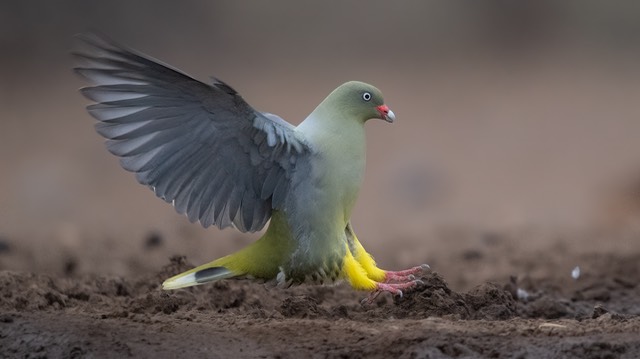
Focus: Focus speed is probably the biggest drawback of being a consumer lens. While the 180-600mm f/5.6-6.3 VR is not a slug in focusing, nor is it a speedball. Tracking fast moving objects is not an issue. It’s acquiring a focus where you might see the compromise Nikon made. For most subjects, particularly ones that were static and large, there’s no issue. For birds in flight (BIF), particularly distant ones, you start to see the issue. (Note: I have not tested the lens with the new Z9 4.1 firmware.)
If you’re well out of focus when trying to acquire a BIF, there’s a strong chance that you’ll slide to focus, go beyond, come back and hunt. If you were close to focus in the first place, the lens will snap into focus and track. But on a long hunt to get the BIF focused, I found that the number of times where the camera/lens didn’t lock on a bird (Z8/Z9) was higher than that of the 100-400mm f/4.5-5.6 VR S or the 400mm f/2.8 TC VR S. That said, I obviously had a lot of success with the lens with BIF on my most recent trip.
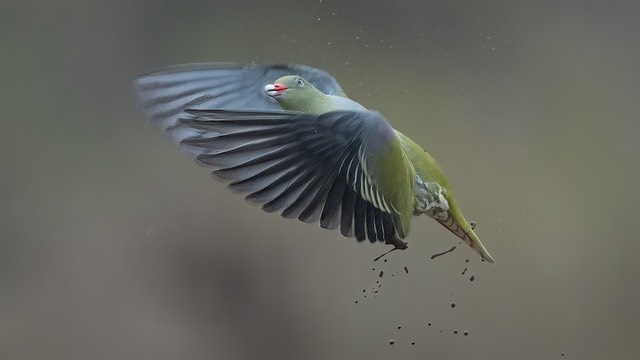
Using the Focus Limiter (6m to infinity) helps considerably with finding the bird faster, but it can still be a problem. Zooming out to 180mm and getting the bird in focus at the shorter focal length first helps, too. But the number of focus misses when trying to swing to the bird at 600mm and follow it when the lens wasn’t already focused near the bird’s distance was clearly and significantly higher than with the two lenses I mentioned in the last paragraph.
I don’t find this to be a condemning attribute, but it is something you need to be aware of. In three weeks in Africa I missed some images because of failure to get initial focus fast enough. Again, however, the lens tracks very well once focus is acquired.
Some will ask how the 180-600mm f/5.6-6.3 VR compares to the F-mount 200-500mm f/5.6E in focus speed. I’d say the new Z-mount lens is a little faster to focus, but a little more likely to hunt on a long focus pull.
Price, of course, suggests that Nikon had to make compromises somewhere. My judgement is that focus speed to initial acquisition is one of those places where that shows up some.
Surprisingly, the lens has very little focus breathing, though it's there (about 1-4% from near to far, with the higher amount as you zoom in; but remember, the lens goes to 1:4 magnification, so the lens has a longer focus range than most). For video work, the types of focus pulls you're likely to do aren't going to produce problematic angle of view changes. Moreover, this is better than the fast, exotic lenses achieve.
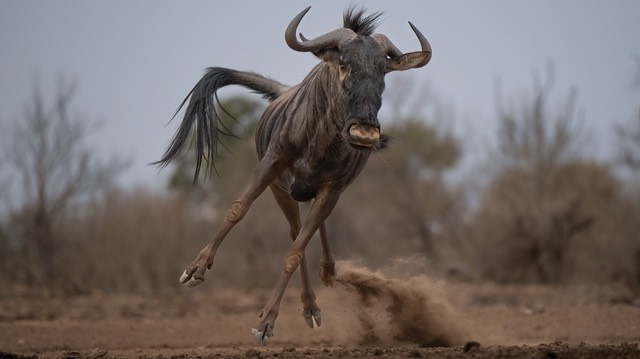
Sharpness: Surprising for the price. At 180mm the lens is pretty much very good+ from center to corner. I see a little bit of difference near the DX boundary, but not enough to change the assessment. Stopping down any gets the center and DX corners to excellent, while the FX corners remain very good. If there's a weakness, it would be a very slight decrease in overall contrast compared to what I see in the much more expensive exotics.
In the middle focal lengths (~300mm), the lens gets slightly better in the center and DX corners, but again, you have to stop down (even a third of a stop) to get the very best results. Again, the FX corners are a bit down from what I define as excellent. Still, you wouldn't expect to see this much ability to hold sharpness and contrast into the corners at this lense's price point.
At 600mm, the center at f/6.3 is somewhere in the very good range, and again stopping down any will improve that until diffraction starts to become an issue. The DX corners are probably at very good- using my criteria. The FX corners still hold up fairly well, a really strong good (though with a slight loss in contrast and a slight blur), particularly considering the price point of this lens and the competition it's up against.
Let me restate the obvious: while not a stunner in terms of sharpness, this lens is plenty sharp wide open at any focal length with a stronger center than corner, but the corner is not soft and blurry. You’re going to have a difficult time seeing any issues with this lens without pixel peeping, and even then many of you will still have difficulty.
Note that if you use the 180-600mm f/5.6-6.3 VR at minimum focus distance, the corners do go soft, due to field curvature. You need to stop down at least two stops to bring them up to what I'd call usable at minimum focus distance, whether at 180mm or 600mm. But at 600mm you're at a magnification ratio of 1:3.9, which is quite impressive. Central performance is really good wide open, so if you're photographing things like small insects, you might find this lens remarkable.
My initial assessment is that this lens is best at 300mm. But it doesn't show a lot of fall off at other focal lengths. It’s a strong 600mm and a reliable 180mm, too.
There's also almost no coma.
With teleconverters, strange things happen. For instance, with the 2x, the DX corner stopped down a stop looks to me to be excellent-, but the center is clearly far down from that. Wide open, the FX corner looks okay, but there's clearly far less sharpness than without the teleconverter. The center, by the way, is probably only fair+ with the 2x, and that’s the reason why I wouldn’t recommend the lens with the 2x teleconverter.
The 1.4x fares much better. Wide open I find the center and DX corners to be good-, and the FX corners to be good+ (I told you it was strange). Stopping down even a bit produces some very good looking images. If you’re going to use this lens with a teleconverter, the 1.4x is really the only choice that makes sense to me.
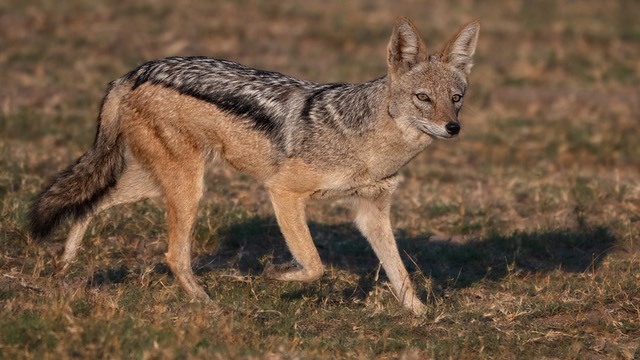
A nearly full image at 840mm (cropped to 16:9, and using the 1.4x teleconverter). And below is the actual pixels without any sharpening. You can see a bit of fuzziness here near the DX border; the face and ear hairs aren't showing clean definition.
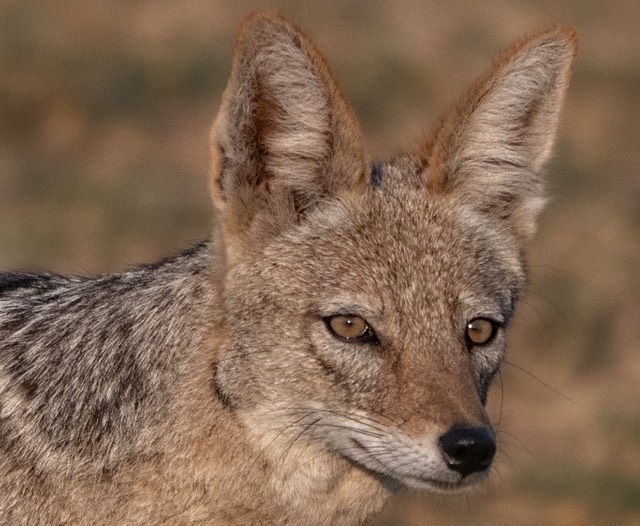
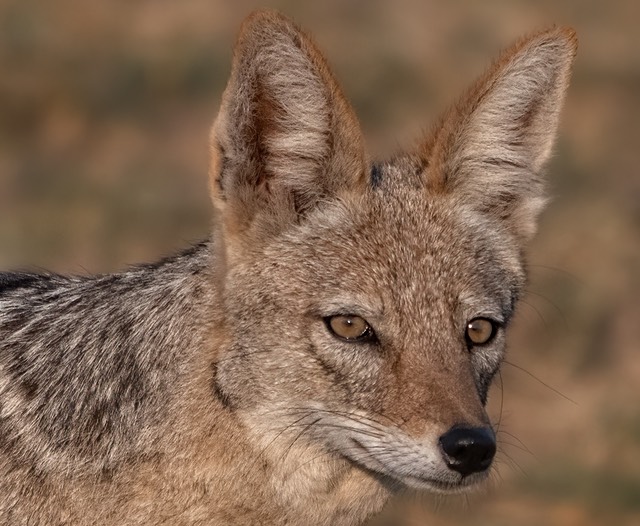
A bit of Topaz AI starts to resolve the hairs again.
Chromatic Aberration: Surprisingly, I see a bit of longitudinal CA, though it's very minor and not at all problematic in actual photographic situations. Lateral CA is also present in very minor form. Imatest results tend to say about a pixels worth at most focal lengths, with 600mm rising to 1.5-2 pixels worth. While I can see that in some images, the actual visual impact is low, and easily dealt with in post processing.
Vignetting: At 180mm I wouldn't be at all concerned with vignetting (it's right at my "ignorable" boundary of a half stop). Yes, the left/right edges drop down a bit, but the lens corrections pretty much fully fix this, and it isn't a bad visual impact in the first place due to a broad unaffected portion of the image circle. At 600mm, however, the full exposure image circle narrows considerably, so that there's much more of a spotlight effect, though still more modest than I was expecting (somewhere between 1-2 stops in the extreme corners). However, by f/8 the vignetting is ignorable. Moreover, the lens profiles seem to do a good job of providing a non-vignetted look.
Linear Distortion: This is one area where Nikon chose to not correct. There's obvious pin-cushion distortion (~1%) evident already at 180mm, it peaks around 300mm, but it's still present at 600mm. The in-camera corrections do a good job of dealing with this.
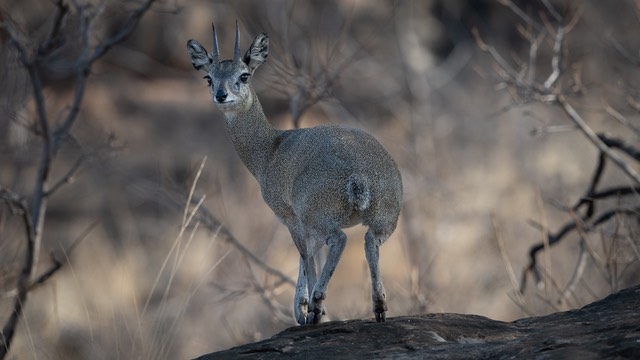
Bokeh: not much of a bright ring on specular highlights, and not colored. Cats eye starts showing up about the DX boundary. Strangely, I find the inner character not so much onion skin (rings), but spotted frog (spots). There's a low-level patchy character to the inner circle.
Final Thoughts
I know, everyone wants comparisons. You want to know which of the many Nikon Z telephoto options to purchase. The 180-600mm f/5.6-6.3 VR makes that tricky first and foremost because of its price. So I guess my first thought is this: if you're totally price conscious, the 180-600mm f/5.6-6.3 VR (possibly coupled with the 70-180mm f/2.8) is your choice, hands down. There's a lot of value for price here.
The first lens that people ask about for comparison is the 100-400mm f/4.5-5.6 VR S. Generally, yes, in the same range the 100-400mm is a bit better lens, and it's going to be faster at all focal lengths, so there's the question of whether you're photographing in low light that has to be dealt with, too. To me, if you're not buying the 70-180mm or 70-200mm lens, the 100-400mm f/4.5-5.6 VR S is the clear lower end telephoto choice you should opt for. It's versatile, this older zoom produces great results, it's reasonably teleconverter friendly (particularly the 1.4x), and there's little to fault with it. Moreover, the 100-400mm f/4.5-5.6 is smaller and lighter than does the 180-600mm f/4.5-5.6 VR S, and is thus more travel friendly for some. I wrote in my review of the 100-400mm that the 180-600mm would have a high bar to get over. That's correct. The 180-600mm mostly gets over that bar by having 400-600mm and a low price.
The second lens that gets mentioned is the 200-500mm f/5.6E ED VR (on an FTZ adapter). You'll probably be selling your 200-500mm, if that's what you're using. At 500mm wide open the 180-600mm f/5.6-6.3 VR is clearly better, plus you can go to 600 (still better)!
Next up are the fixed focal length lenses. In particular, two: the 400mm f/4.5 VR S and the 800mm f/6.3 PF VR S. I wouldn't include the 400mm f/2.8 TC VR S or 600mm f/4 TC VR S against the lens I'm reviewing here for a simple reason: you pay their big prices for every last nuance of image quality. If you want that level of image quality, you pay for it, you don't consider an inexpensive 180-600mm f/5.6-6.3 VR as a potential replacement.
So: at 400mm the 400mm f/4.5 VR S is the better lens, and clearly so. In particular, better contrast and a faster aperture (by almost a stop) at 400mm. The prime takes teleconverters better, too. But yes, you're at 400mm max focal length. It's just a pretty fabulous 400mm that the 180-600mm f/5.6-6.3 VR won't match. On the other hand, the 400mm f/4.5 VR S with the 1.4x teleconverter produces a 560mm that the 180-600mm f/5.6-6.3 VR does come close to matching.
If you're always at 600mm I'm going to ask a simple question: do you want more focal length? Then get the 800mm f/6.3 PF VR S and forget trying to put teleconverters on the less expensive lens. It isn't even close.
There's nothing badly wrong with the 180-600mm f/5.6-6.3 VR. As I hinted at in the performance section, above, for its price it is arguably knocking it out of the park, even more than the 200-500mm f/5.6E did in the DSLR days. Stop the 180-600mm lens down to f/6.3 at 180mm or f/7.1 at 600mm and it generates hard to beat sharpness against almost any competition other than the full-on exotics.
The really good news here is that Nikon has been fleshing out really solid lens choices at a variety of levels. The lowest level, to which the 180-600mm f/5.6-6.3 VR essentially joins, is remarkably better than you probably remember things being in the DSLR era. Coupled with the Tamrikon f/2.8 zooms, you can put together a 17-600mm kit in four lenses that together costs less than a Z9. Two of those lenses are near outstanding, one is really good (the one I'm reviewing here), and the last one (24-75mm f/2.8) decently above adequate.
But you can do better in the Z mount. Far better. Optically, the 14-24mm f/2.8 S, 24-70mm f/2.8 S, 70-200mm VR S, and 400mm f/4.5 VR S are better at all equivalent focal lengths. Plus you have in between choices: 14-30mm f/4 S, 24-120mm f/4 S, 100-400mm f/4.5-5.6 VR S. So really, in the zoom realm, Nikon has now produced three fairly distinct levels both in performance and price. Which gives you a lot of choices to contemplate.
Again, though, the 180-600mm f/5.6-6.3 VR is hitting above its weight class, particularly if you can stop down even a third of a stop. I wouldn't avoid this lens, at all, and as I just demonstrated in Botswana, it's clearly up to the job when used well.
Recommended (2023 to present)
Support this site by purchasing from the following advertiser:
